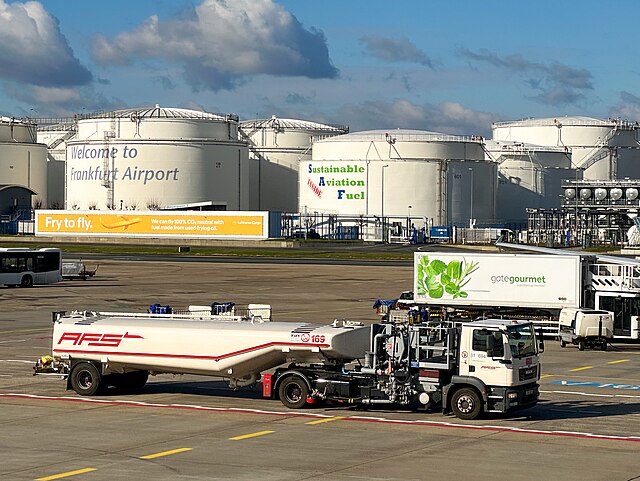When on a flight, pilots usually carry passengers and cargo. But, for a change, they are also carrying extra fuel. Why? Well, it’s all about saving money. Let’s find out how.

Fuel tankering is when an aircraft deliberately carries more fuel than it actually needs for the journey. This extra fuel acts as a reserve Airlines do this for a simple reason: to avoid refueling at their destination airport, where fuel might be more expensive.
What’s the strategy behind fuel tankering?
Airlines load up on extra fuel if the departing airport offers cheaper fuel prices than the destination. It’s like filling your car’s tank when gas prices are low – you’re stocking up for the road ahead. But there’s a trade-off. Carrying all that extra fuel adds weight to the aircraft, which means more fuel consumption during the flight. It’s a delicate balance, a complex equation, between the immediate cost savings and the long-term environmental impact.
Fuel prices can vary significantly between airports. Some airports offer cheaper fuel than others due to local taxes, supply agreements, or market dynamics. While tankering saves money, it also leads to higher carbon emissions, contributing to aviation’s environmental impact. The strategy involves considering both financial benefits and environmental consequences. So, how big of a problem is it, and how much should we be concerned?
Drawbacks of fuel tankering.
Let’s delve into the intricacies of fuel tankering and explore its drawbacks in detail:
Increased Fuel Burn:
Carrying extra fuel means the aircraft is heavier, which leads to higher fuel consumption during the flight. The trade-off is straightforward: While tankering saves money by avoiding expensive refueling at the destination, the extra fuel burn increases operational costs.


Environmental Impact:
Fuel tankering directly contributes to increased carbon emissions. The additional fuel burned releases more greenhouse gases into the atmosphere. Multiply this impact across thousands of flights, and it becomes a significant environmental concern.
Reduced Payload Capacity:
The extra fuel load displaces space that could otherwise be used for passengers, cargo, or other essential items. Airlines must strike a balance between fuel savings and payload capacity. If they prioritize tankering less, it affects revenue-generating opportunities.
Complex Flight Planning:
Tankering requires meticulous flight planning. Airlines must consider fuel prices at departure and destination airports, route distances, and aircraft performance. This complexity can lead to errors or suboptimal decisions if not managed carefully.
Operational Constraints:
Tankering works well for short-haul flights with predictable fuel prices. However, it becomes riskier on longer routes or when fuel prices fluctuate unexpectedly. Airlines may find themselves carrying excess fuel that isn’t cost-effective.
Regulatory Challenges:
Some aviation authorities discourage tankering due to environmental concerns. They may impose penalties or restrictions. Balancing cost savings with regulatory compliance is a delicate task.
Maintenance Implications:
Extra fuel weight stresses the aircraft structure, landing gear, and components. Airlines must closely monitor wear and tear, conduct more frequent inspections, and address maintenance issues promptly.
Market Volatility:
Fuel prices are subject to market fluctuations. What seems like a good tankering decision today may not hold true tomorrow. Airlines must adapt their strategies based on real-time data and market dynamics.
Public Perception:
Some passengers may perceive tankering as a cost-cutting measure compromising safety or environmental responsibility. Airlines need to communicate transparently about their practices to maintain trust.
How many aircraft engage in Fuel Tankering?
Eurocontrol research indicates that approximately 15% of European Civil Aviation Conference area flights engage in full fuel tankering, while an additional 15% use partial fuel tankering to minimize refueling expenses. The environmental impact of fuel tankering results in additional CO2 emissions, contributing to aviation sustainability concerns.
According to the ECAC report, “Over the 10 million annual flights…… it was estimated that 2.1 million are able to perform fuel tankering, distributed as follows: 1.6 million flights are able to perform full tankering (16.5%), and 0.45 million flights are able to perform partial tankering (4.5%).”


Out of those 2.1 million, British Airways was one of the major airlines involved in fuel tankering, producing 18,000 tonnes of CO2.
How do airlines decide when to engage in fuel tankering?
Airlines decide when to engage in fuel tankering based on several factors. Here are some considerations:
- Fuel Price Discrepancy: Airlines compare fuel prices at their departure airport (where fuel is loaded) with those at their destination. If the price difference is significant, they may choose to carry extra fuel.
- Route Distance: Longer flights benefit more from fuel tankering because the savings on refueling costs outweigh the additional fuel burn due to the extra weight.
- Aircraft Type: Larger aircraft can carry more excess fuel without significantly impacting efficiency. Smaller planes may avoid tankering due to weight limitations.
- Operational Constraints: Airlines consider operational factors like payload, weather conditions, and alternate airports. Carrying excess fuel affects payload capacity and may limit other cargo or passenger loads.
- Environmental Impact: Airlines balance cost savings with environmental concerns. Fuel tankering increases emissions, so airlines weigh the financial benefit against sustainability goals.
Are there any regulations or guidelines regarding fuel tankering?
Since fuel tankering can lead to increased fuel consumption and unnecessary greenhouse gas emissions, certainly there are some relevant regulations and guidelines:
EU Regulation 2023/2405 (ReFuelEU Aviation): This regulation aims to ensure a level playing field for sustainable air transport. It addresses fuel tankering by aircraft operators and emphasizes environmental protection. Fuel tankering undermines efforts to reduce emissions and achieve climate goals.
EASA Regulations: Under the European Aviation Safety Agency (EASA) regulations (CAT.OP.MPA.150 Fuel policy), pilots must ensure that the amount of fuel onboard covers the entire flight, including deviations from the planned operation. Both full and partial fuel tankering are discouraged. Before departure, captains must ensure that every flight carries sufficient fuel for the planned operation and reserves to cover deviations from the planned operation.


ReFuelEU Proposal: The European Commission’s proposal includes an “anti-tankering” provision. At Union airports, airlines must uplift at least 90% of the fuel needed to operate flights from that airport, limiting the amount of tankering allowed.
These regulations discourage fuel tankering and promote more efficient fuel management in aviation.
Why Does The U.K. Opposition Want To Ban Fuel Tankering?
The UK’s leading opposition parties, including Labour and the Liberal Democrats, advocate banning fuel tankering by airlines. Fuel tankering involves carrying excess fuel on flights, which can lead to increased emissions and environmental impact. While the UK Government won’t introduce a minimum fuel requirement for airlines departing from UK airports when the UK Sustainable Aviation Fuel (SAF) Mandate starts in 2025, further research will assess tankering once the mandate is operational.
The goal is to promote sustainable aviation fuel and reduce greenhouse gas emissions in the aviation industry. Flights originating from the United Kingdom could be responsible for half of the tankered flights, and eliminating tankering on UK flights to Europe would increase SAF sales at EU airports by almost 20%.
What are the benefits of banning fuel tankering?
When it comes to banning fuel tankering, there are several benefits:
- Reduced Carbon Emissions: By discouraging tankering, airlines can minimize unnecessary fuel consumption during flights. This directly contributes to lowering carbon dioxide emissions, which is crucial for environmental sustainability.
- Improved Efficiency: Without tankering, airlines operate with the optimal amount of fuel required for each flight segment. This efficiency leads to better overall performance, reduced weight, and improved fuel economy.
- Environmental Responsibility: Banning tankering aligns with global efforts to combat climate change. Airlines play a significant role in reducing their environmental impact and avoiding excess fuel uplift is a step in the right direction.


While these benefits exist, it’s essential to strike a balance between economic considerations and environmental responsibility.
Are there any alternatives to banning it completely?
Instead of an outright ban, airlines and aviation authorities can consider the following alternatives to mitigate the drawbacks of fuel tankering:
Optimized Tankering: Airlines can use sophisticated algorithms to calculate the optimal amount of fuel needed for each flight. These algorithms take into account factors like weather conditions, aircraft type, and route length. By minimizing excess fuel, airlines can reduce weight and emissions while still ensuring safety.
Dynamic Fuel Pricing: Airlines could implement pricing models that incentivize fuel efficiency. For instance, airports could offer lower landing fees to airlines that carry less fuel. This would encourage airlines to operate with minimal tankering and reduce unnecessary weight.
Collaboration and Data Sharing: Airlines can collaborate to share data on fuel consumption and best practices. By learning from each other’s experiences, they can collectively improve fuel efficiency and reduce the need for tankering.
Regulatory Guidelines: Aviation authorities can establish guidelines that discourage excessive tankering. These guidelines could include penalties for airlines that consistently carry excessive fuel without valid reasons.
Eco-Friendly Technologies: Investing in more fuel-efficient aircraft and alternative fuels can significantly reduce the need for tankering. Airlines can explore sustainable options like biofuels or electric planes.
A look at Sustainable Aviation Fuels (SAFs)
Sustainable Aviation Fuels (SAFs) are drop-in fuel blending components derived from renewable or waste-based feedstocks. Compared to petroleum-based fuels, SAFs provide reduced carbon dioxide emissions.


SAFs are biofuels used to power aircraft. They have similar properties to conventional jet fuel but with a smaller carbon footprint. SAFs can be produced from various sources, including:
Corn grain Forestry residues
Oil seeds Wood mill waste
Algae Municipal solid waste streams
Other fats, oils, and greases Wet wastes (manures, wastewater treatment sludge)
Agricultural residues Dedicated energy crops
Benefits:
- Reduced Emissions: SAFs significantly lower life cycle greenhouse gas (GHG) emissions compared to conventional jet fuel.
- Economic Opportunities: Growing and producing SAFs can create new economic opportunities for farming communities.
- Environmental Impact: SAFs improve the environment by utilizing renewable or waste resources.
SAFs are certified jet fuel (Jet-A/A1). Unlike traditional jet fuel, fully derived from fossil resources, today’s SAF is a blend of conventional fossil fuel and synthetic components made from renewable feedstocks.
Are there any challenges in adopting SAFs?
While Sustainable Aviation Fuels (SAFs) offer significant benefits, their adoption faces several challenges. Due to limited production capacity and economies of scale, producing SAFs is currently more expensive than conventional jet fuel. As production scales up, costs are expected to decrease. Here are a few more challenges:
- Feedstock Availability: SAFs rely on renewable feedstocks like algae, crop residues, or waste oils. Ensuring a consistent and sustainable supply of these feedstocks can be challenging.


- Infrastructure: Existing infrastructure (refineries, pipelines, and distribution networks) is designed for conventional fuels. Adapting it to handle SAFs requires investment and planning.
- Certification and Standards: SAFs must meet rigorous certification standards to ensure safety and compatibility with existing engines. Developing and maintaining these standards is essential.
- Public Perception: Educating the public and airlines about SAFs’ safety, performance, and environmental benefits is crucial. Overcoming skepticism and fostering acceptance is a challenge.
Despite these obstacles, ongoing research, policy support, and industry collaboration aim to accelerate SAF adoption and create a more sustainable aviation sector.
